skip to main |
skip to sidebar
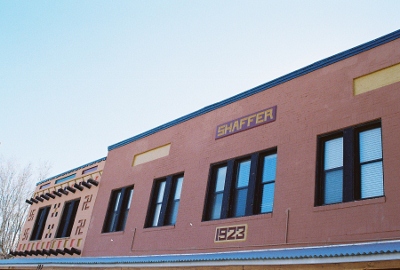
There’s nothing quite like a night in an old hotel. Last year we stopped by the St. James Hotel up in Cimarron and now we’ll check out the Shaffer Hotel in Mountainair. Mountainair, about 90 minutes south of Albuquerque, was named for the fresh breezes that blow off the surrounding mountains and down through the town. Mountainair is also the self-proclaimed “Pinto Bean Capital of the World.” This second claim to fame tells you something about what most people in Mountainair do for a living.
Established in 1903, Mountainair soon attracted the attention of Clem “Pop” Shaffer, a blacksmith who arrived in 1908 to work his trade and sell useful items like caskets and coffins. Mr. Shaffer built a hotel out of wood which promptly burned down. So, in 1923, he built another hotel, this one out of cast concrete and various bits of iron that he collected from wherever he could. This hotel would not burn down.

But the fact that the Shaffer Hotel is made of concrete is almost entirely obscured by its ornamentation, a mesmerizing mixture of Native American symbolism, fantastic creatures, and menacing characters of unknown origin. While loosely considered “Pueblo Deco,” Pop Shaffer’s vision is almost too singular and idiosyncratic to fit the term. While not exactly comforting, the hotel’s artwork, which includes painting, sculpture, and numerous things made out of rocks, all created by Pop himself, is pretty incredible. And, yes, it is jarring to see what appear to be swastikas scattered about. However, this is not the Nazi swastika, but a Navajo symbol, sometimes called "whirling logs," that represents healing and can face either left or right. Four large whirling logs that originally lined the top of the hotel have been covered over.
While loosely considered “Pueblo Deco,” Pop Shaffer’s vision is almost too singular and idiosyncratic to fit the term. While not exactly comforting, the hotel’s artwork, which includes painting, sculpture, and numerous things made out of rocks, all created by Pop himself, is pretty incredible. And, yes, it is jarring to see what appear to be swastikas scattered about. However, this is not the Nazi swastika, but a Navajo symbol, sometimes called "whirling logs," that represents healing and can face either left or right. Four large whirling logs that originally lined the top of the hotel have been covered over.
Pop Shaffer’s hotel did well for him and he added a Ford showroom and garage in the back of the place, alongside the coffin workshop. A restaurant was opened next door, the ceiling lavishly carved and colored. Each day, like clockwork, Pop’s second wife, Lena, went shopping for food and provisions. This gave Pop a little time for extracurricular activities, but one day Lena returned unexpectedly to find her husband climbing the stairs to the rooms of the hotel with another woman in tow. Lena produced her pistol as the mistress drew hers. However, as was common in those days of unpredictable side arms, both shots went very wide of their marks. Lena’s bullet hit the ceiling behind the staircase. The mistress’s lodged in the molding of the ceiling opposite the staircase. One has to wonder what Pop Shaffer thought of this incident. I have found no record of how this domestic crisis was resolved, but it did not end in divorce.
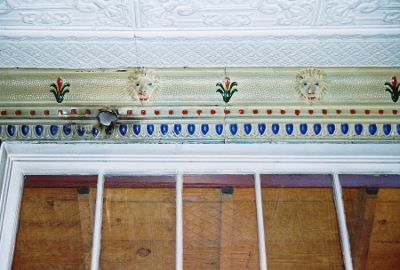
There are those that say Pop Shaffer still resides in his hotel. A man who hung himself in Room 16 is also said to haunt guests. I was told that the previous Halloween a father had requested that he and his daughters be given the most haunted room in the hotel. The man was put in 16 and his daughters got the adjoining room of the suite. In the middle of the night the man went to use the bathroom and felt a chill then turned to see the outline of a body on the bed. He attempted to go to his daughters but was unable to unlock the door to their room. They awoke and were likewise unable to open the door from their side. Early the next morning the woman that runs the front desk came in to find the man and his daughters sitting downstairs. The girls were crying. The man said they weren’t staying another night and the hotel could keep their money as far as he was concerned. The desk woman said she made the refund anyway. I couldn’t convince MLE to stay in 16 so we took an adjacent room where I slept quite well but she did not, feeling a little rattled by the general atmosphere.
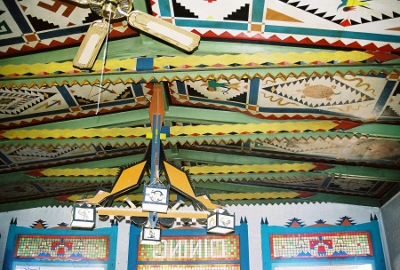
While we weren’t haunted by ghosts, the night we stayed at the Shaffer one of the women that worked at the hotel was being stalked by an ex-boyfriend who threatened to shoot everyone inside. He drove by a couple times and the police were called. At one point, while eating in the restaurant, we were asked to step away from the front window. For a few minutes we drank our tea by the cash register, waiting to see which way things would go. But, in the end, there was no gunfire at the Shaffer that night, surely how Pop would prefer it.
Not far from the Shaffer Hotel is Pop’s old residence, Rancho Bonito. Guarded by an alarming wooden creature and comprised of two fairly small buildings that are perhaps even more colorful and fanciful than the Shaffer, it’s very much worth a look. Both the hotel and Rancho Bonito are on the National Register of Historic Places. The Shaffer is for sale or lease if you want to own or operate a piece of history. Accommodations range from “cowboy” rooms with no bath to spacious suites. I’m sure all ghosts will be included at no additional charge.
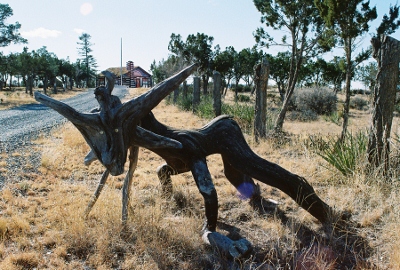
Information for this post mostly came from the Shaffer Hotel's now-gone website. A bit more came from a personal tour of the place and the rest from lived experience.
JANUARY 2016 UPDATE: The Shaffer and its restaurant have opened and closed a couple times since this post was written almost exactly four years ago. In mid-2015, it was shuttered again and, sadly, shows no signs of re-opening anytime soon.
MARCH 2020 UPDATE: The Shaffer and its restaurant have opened again! Such great news! You can find them on FACEBOOK and rooms are available on Airbnb.
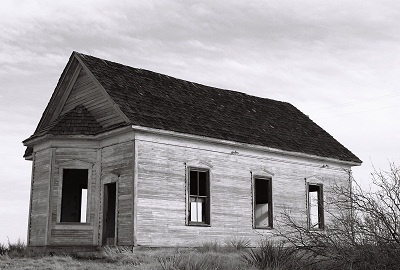
Let’s start the New Year by departing Yeso and traveling Highway 60 east, past Fort Sumner, final resting place of Billy the Kid (we’ll return to Fort Sumner…eventually), to the unincorporated town of Taiban, New Mexico. Taiban is known for its old Presbyterian Church, a lonely, gutted house of worship visited by photographers and the traveling faithful. The church, once part of a neighborhood which included homes, businesses, and the two-story Taiban High School, now sits by itself out on the prairie. Not a single business remains in Taiban. But it was not always this way.
Like Yeso, Taiban was named for a nearby creek. The source of Taiban Creek was Taiban Spring, originally known as Brazil Spring after a Portugese immigrant, Manuel Brazil, who arrived in 1871, the first recorded settler in the area. The meaning of the word “Taiban” is obscure, although it’s thought it might be a Navajo or Comanche word for “horsetail,” a reference either to a local plant or to three small tributaries that flowed into the creek. It’s said that Billy the Kid watered his horse at Taiban Spring.
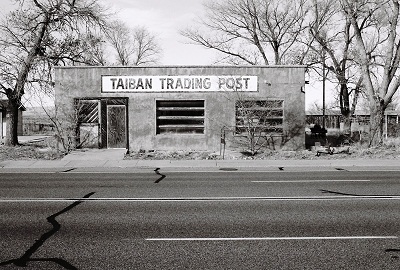
Also like Yeso, Taiban owed its existence to the railroad. Taiban was founded in 1906, when the Belen Cut-off was laid across the eastern plains of New Mexico, re-directing rail traffic from the mountainous north. A school was built and contracts were drawn for the construction of fifty homes. By 1907, there was a bank and a hotel. In 1908, the Atchison, Topeka, and Santa Fe Railroad began actively encouraging settlement of the region. Over 1,300 trains passed through the plains bringing homesteaders from across the country. But the vast majority of emigrants did not settle in Taiban and, in 1909, the town’s population peaked at 400 residents. These were mostly farmers and sheepherders, already veterans of conflict with both the landscape and established ranching interests.

In the fall of 1908, construction began on the First Presbyterian Church of Taiban. It was completed on December 22, 1908 at a cost of $250, less than $100 of which could be covered by the congregation, necessitating loans from the ladies of the Baptist Church, as well as the Taiban Savings Bank. The first sermon, given by Reverend John R. Gass, was sparsely attended due to cold weather.
Shortly after Taiban was founded a heated controversy erupted over the construction of The Pink Pony Saloon and Dancehall, which, in addition to selling alcohol, was to hold cockfights and house a snake den in its basement. Opened amidst great consternation, the Pink Pony became the only one of 40 businesses operating in Taiban in 1908 to survive into the latter part of the 1930’s.

A settler, Vane Outias, describes his experience arriving in Taiban: "There we were. Piling down off the steps of the jerk-water train at Taiban, New Mexico; Pa, Ma, and the kids. After counting the suitcases, the packages, and the bundles, Ma called the roll. All were present. The bunch of us with Ma herding started for the hotel. We had come out here to file on some land: make a living farming; and when we had proved-up, sell out and go back east (rich).
"On the way to the hotel I made observations for my own particular benefit, namely, there were two places in town which would have thrown Carrie Nation into a frenzy if she had been one of our party, Watch me hurry, as I had come from a dry state. Just as soon as I could find an excuse I was admitted to the bar of the first emporium. I meant to say; when I found an excuse that the Missus would accept.”
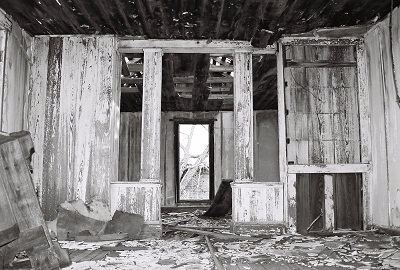
Thus alcohol and religion squared off, vying for the soul of Taiban, whose heart was being broken by the farming of an inhospitable and increasingly barren land. Some years the church won out and Taiban was dry. Other year’s, those laws were overturned and Taiban was once again wet. Into the 1930’s, as the Depression and drought deepened, families left the area. Following Prohibition, it was largely liquor that kept Taiban from blowing away entirely. For nearly all of the town’s existence the Taiban Presbyterian Church had played a vital role in the spiritual life of the community, serving Methodists and Baptists, as well, but, with congregations dwindling, the last service was held in 1936.
After WWII, only seven businesses operated in Taiban, which now had a population of 50. The bars were most successful and customers from dry counties in west Texas and Oklahoma came out for a drink. The town even had an airfield, Taiban International Airport, and the wealthy would fly in to purchase liquor. People as far away as western Oklahoma knew Taiban’s reputation as the “bootlegging capital” of eastern New Mexico and west Texas.
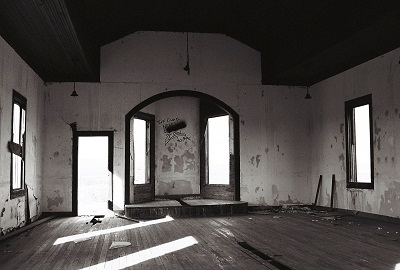
But alcohol isn’t enough to save a town that has lost all hope of real prosperity. Passenger and express train service had ceased in Taiban in 1933, the same year telegraph service was discontinued. New highways and decades of difficult-to-impossible dry farming drove nearly all the residents of Taiban elsewhere until, by 1960, only one business remained; a bar. And now there are none.
While the battle between God and alcohol played out for many years in Taiban, walking the town site now it appears there was no clear winner. The bars are all gone and turned to dust. The little church stands vacant and exposed, the bell tower removed in 1960, the baby grand piano sold, the doors and windows destroyed by vandals. So, let’s call it a draw…for now. Visitors are starting to leave prayers in the alcove of the church, behind where the old walnut pulpit used to be, so perhaps it will have a new life yet. In the meantime, if you want to see such a fight for yourself, this same battle continues to be played out in towns all across America. Maybe your town is one of them.
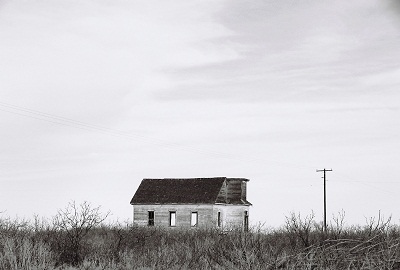
Information for this post came from Highway 60 & the Belen Cutoff, by Dixie Boyle. The great quote from Vane Outias was found at THIS De Baca County website. Oddly, although almost no internet sources recount Taiban’s history, one that does offers an incredibly detailed account. Compiled in an attempt to get the Taiban Presbyterian Church on the state Register of Cultural Properties, THIS was my major source for this post. I don’t believe the effort to get the church listed was successful. For once, Philip Varney gave me nothin’.
I'd be thrilled if anyone could confirm that there's a Blind Willie McTell record in the window of the trading post pictured above. It's on the opposite side of the picture from the Ross Perot shirts. It would have to be a later period photo, sometime around the "LAST SESSIONS" recording. Anyone? (MAY 2015 UPDATE: It's not Blind Willie McTell, but his former classmate at the Georgia Academy for the Blind, Rev. Pearly Brown, shown on the cover of Wet Willie's "Keep on Smilin'" LP. Thanks Cox family!)
SEPTEMBER 2012 UPDATE: Below are two fantastic postcard images of Taiban. The first is of Main Street, taken from the east. Based on the 1908 postmark, the photo can be from no more than two years after Taiban's founding in 1906. The second is of Billy the Kid's hideout in the area, which has been reduced to nothing more than a foundation now, if even that. Both were submitted by Dave S. Here's what Dave had to say about the postcards, as well as Billy the Kid's capture at Stinking (aka Taiban) Spring in 1880:
"Thought you and some of your posters would like to see these images. I’m an inveterate postcard collector, and found these at one of my haunts. The first is postmarked Sept. 22, 1908 (can’t make out where it was postmarked). I also happen to be an uncrowned 'World’s Foremost Authority on Billy the Kid.' I snatched these up because BtK (and a few of his comrades) were captured at a rock house at Stinking Spring(s) (also called Cedar Spring, Brazil Spring, Taiban Spring, or just 'the spring') in the vicinity of Taiban, on Dec. 23, 1880. (He later escaped.) Frederick Nolan says the spot was first recognized as a strategic location by Kit Carson.
"There isn’t a whole lot of detail in the Taiban photo, but it’s very atmospheric. The scan ain’t the greatest, but you can make out the sign at middle left that says 'HOTEL.' That’s about as much detail as can be seen on the original. Much to my chagrin, I learned that the town wasn’t founded until 26 years later. As they say: Never ass.u.me. It cost me the better part of 40 bucks, but as great/rare cards go that’s not too terribly bad.
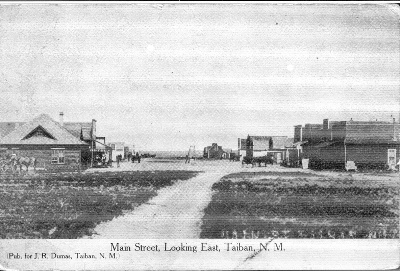
"The second image was clearly not BtK's 'home.' He was on the run and this was just an opportune hideout. And it is only 'said' to be the house where Billy was captured. The proof is not iron-clad. Although he provides no citation, Frederick Nolan avers in The West of Billy the Kid that, 'The rock house was a stark stone structure about thirty-feet long and twelve-feet wide, with a rough opening--no door--about ten feet from one end at the front. Inside were five men and the Kid’s horse; tethered to one of the viga poles outside were…three other horses.' Obviously, this description and the photo are not a great match. One could further cloud matters by noting that the nearby Wilcox-Brazil Ranch was of a similar stone construction. But whatever the location of the house, Billy was soon dispossessed of it, and so began his railroading to the gallows. This definitely occurred near Taiban, at a place called Stinking Spring(s). The “stink” at Stinking Spring(s) is said to be either: of a chemical nature, deriving from near-by geological formations, or caused by “decaying vegetation around it.” [Nolan] So are the twists and swirls around virtually everything Billy. There is no escape.
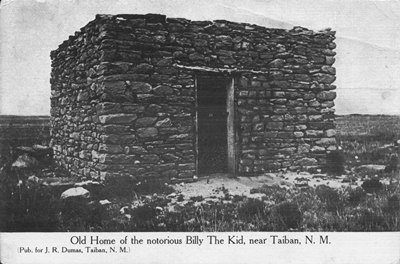
"I’ve been to Taiban, but don’t remember much about it except that there was very little left there. I didn’t try to find the foundation of the stone house, which is all that survives. As I recall, it was a matter of fatigue, and not feeling too terribly welcome there.
"So, anyway, I enjoyed reading your history of the place. I certainly don’t 'own' these images. They're forwarded along to you and yours for whatever purpose they might suggest."
These have to be some of the earliest photos from the Taiban area. I didn't come across them in my research and I imagine they're pretty obscure. So, many thanks to Dave for sending them to City of Dust. Much appreciated!
As a last update (for now), here's a 1925 photograph taken outside the Taiban Presbyterian Church when it was in its full glory. This is from the Application for Registration submitted to the New Mexico State Register of Cultural Properties on behalf of the church. The source of the photo is credited as Susanne Eldridge. So, thanks to her, whoever and wherever she may be.
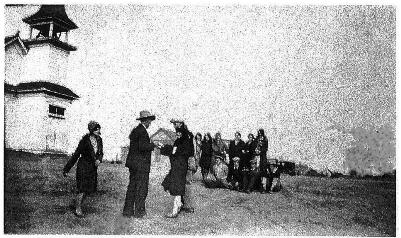
FEBRUARY 2013 UPDATE: A reader recently sent in a wonderful family history of Taiban and a really excellent photo of the town from 1950. The view is looking north with recollections below.
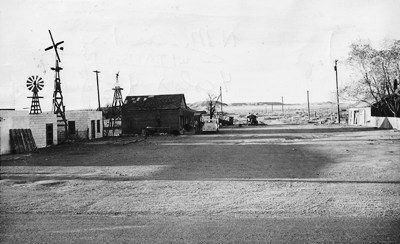
"I bumped into your Taiban, NM site today. My grandparents settled there in 1908. The "Trading Post" was built in 1915 and used by my grandparents in the mid-'50s. The picture credited to Susanne Eldridge is of the church, which is also owned by her. Mac's Bar was just across the street from my grandfather's store and we would watch the cars come and go. Many were bootleggers headed east. My grandfather, J.S. Phillips, came stringing wire for Western Union as the railroad came though. He married my grandmother and settled in Taiban, the "City of the Future." Or at least he thought. He sold Fords and groceries and drilled water wells. He also sold Atwater Kent radios, ran a machine shop, sold gas, and fixed cars. He was very religious and took care of the Church, which was owned by the Presbyterian and Methodist churches. He and my grandmother, Anne Bordeaux, married in 1913. They had seven children and lost a child. I can go on and on. You can go to Facebook and there is a new page, "Remembering Fort Sumner".
David B., Fort Sumner, NM"
Thanks, David! Your contribution really adds a lot to this post. JM
AUGUST 2013 UPDATE: While digging through the dusty corners of the Zimmerman Library at the University of New Mexico a photo of the First Presbyterian Church was unearthed. It's from a rare book titled, "Roosevelt County: History and Heritage," edited by Jean M. Burroughs. Note that the church is actually in De Baca County, about two miles west of the Roosevelt County line. The book was published in '75, so the picture has to be older than that. I'd never seen this spooky shot before, so I thought I'd post it here.
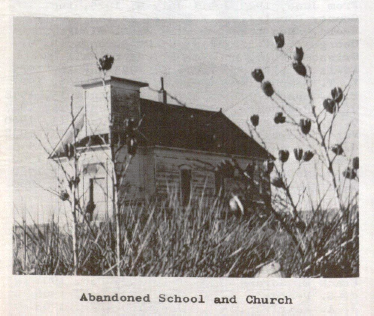
MARCH 2014 UPDATE: Here's something interesting sent in by Rob G. of southwestern Missouri. He found this wrought iron fork at an estate sale and estimates it to have been made between the late 1910's and early 1920's. While it might be hard to read in the photo, it clearly says "TAIBAN" on the back. There aren't many Taiban's in the world, so I have to think this fork might well have come from the little town. I'd love it if someone knew something about this piece.
Thanks to Rob G. for submitting this most intriguing find! JM
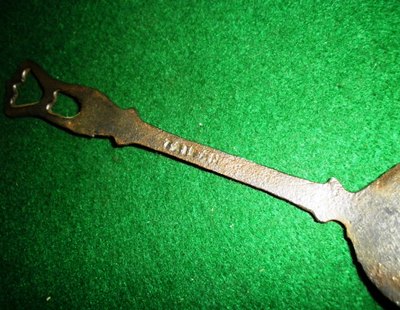
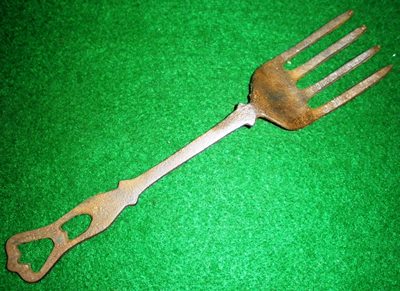
JANUARY 2016 UPDATE: D. Burge has submitted a treasure trove of Taiban-related photographs and scans, including the best (only?) shots I've ever seen of the Taiban school and international (?!) airport. Who knew the two were so close to each other? D. Schuyler also offered some information pertinent to the school and J.S. Phillips Garage. See below for these fantastic photos and descriptions. Thank you very much, Mr. Burge and Ms. Schuyler!

Above is the two-story Taiban school, of which virtually no trace remains. It seems awfully large for a town the size of Taiban and, indeed, only the first floor was used. One room contained grades 1-4, while a second room was for grades 5-8. Beyond that, students went to the high school in nearby Ft. Sumner.
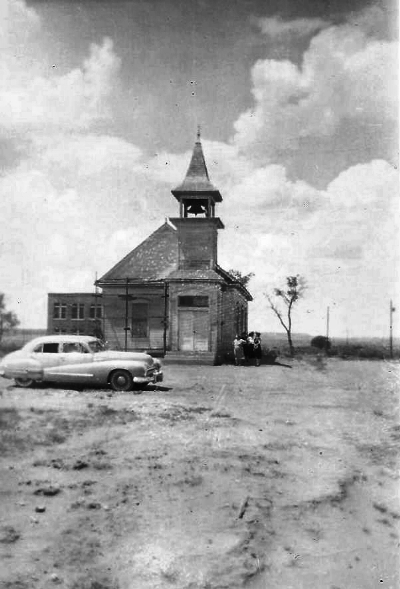
Shown in the wonderful photo above is, of course, the First Presbyterian Church of Taiban in its full glory. Well, aside from the scaffold. Interesting to note is the bit of the school that is also in the frame, just behind the church, pinning down its exact location pretty definitively.
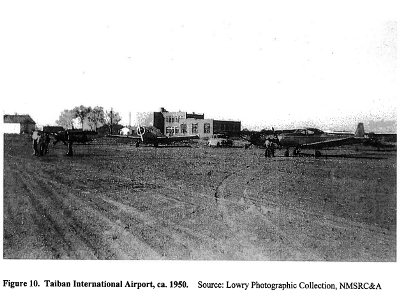
Judging from the scene above the Taiban International Airport was simply the open ground just to the east of the school and church. Perhaps this is how some folks from dry counties in Texas arrived in Taiban to re-stock their liquor supplies. The photo dates from around 1950.
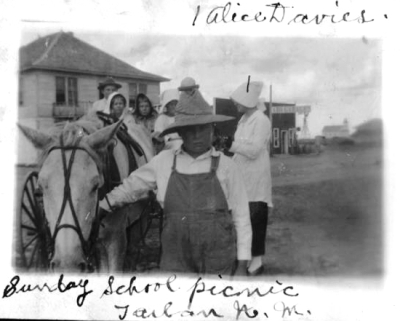
The picture above captures a Sunday school picnic with Alice Davies and her students. Note the Taiban church in the far background. The street immediately behind the picnickers is unrecognizable today.
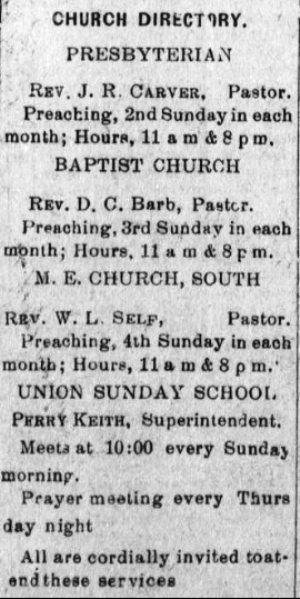
Speaking of Sunday school, the church schedule shown is from the Taiban Valley News and dates to 1917.
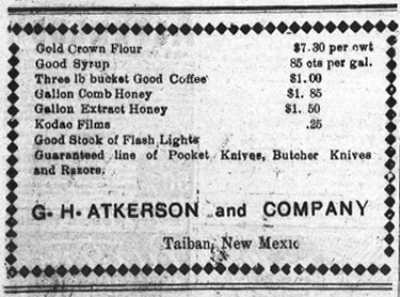
G.H. Atkerson and Company was one of the businesses supplying the items that settlers in the region around Taiban might need or want. Like a gallon of comb honey! Yum! And Kodac Films. I'd like to try shooting some of those films, even if they'd be expired by about 100 years. This is another clipping from the Taiban Valley News of 1917.
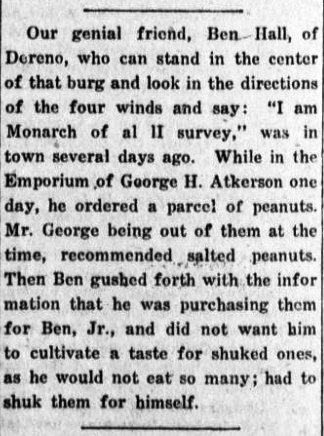
Another thing we know was sold by G.H. Atkerson and Co. were peanuts. And we also know that Ben Hall of Dereno (and founder of the Canyon Blanco Ranch) would purchase them for his son, Ben, Jr. However, not those salted ones! The story above is all the more amusing for its reference to Dereno, a very obscure place in De Baca County that was 12 miles south of Tolar. The post office operated from 1907-1933, but now even the origin of the town's name is lost to the mists of time. This little tale of the dangers of shuked (sic) peanuts is from the Taiban Valley News circa 1921.
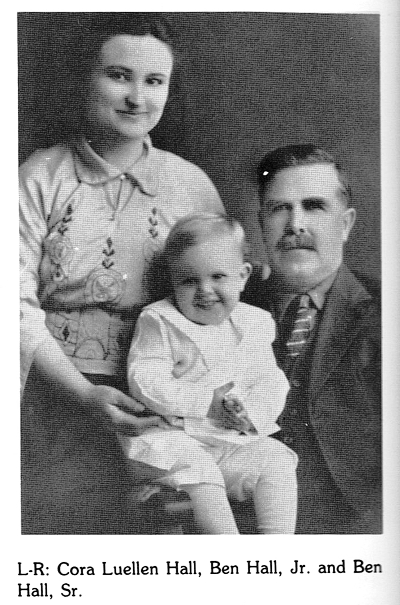
Above is a picture of the monarch of Dereno, NM himself, Ben Hall, Sr., and future peanut connoisseur, Ben Hall, Jr. Mrs. Hall is clearly quite proud! This photo comes from "Living Water: Our Mid-Pecos History: The Families & Events from Fort to Future," a now-rare tome chronicling De Baca County. The book was compiled by Bob Parsons and eight others in 1981 and issued in an edition of 5,000.
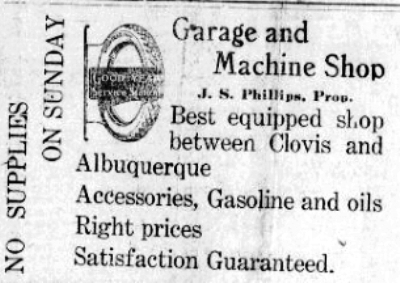
The J.S. Phillips Garage wanted everyone to know that there wasn't much between Clovis and Albuquerque around 1917-1918. They seem to have been well-stocked; you just didn't want to break down on a Sunday. The garage was on the east end of town, one of three open in Taiban by the late-1940's. Descendants of the Phillips family now own the First Presbyterian Church.
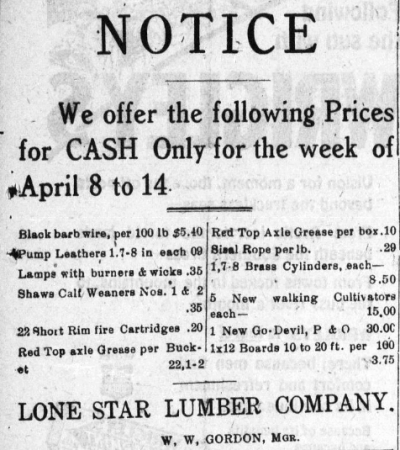
The ad above is for Lone Star Lumber, which supplied a variety of goods, pulled from the Taiban Valley News circa 1918.
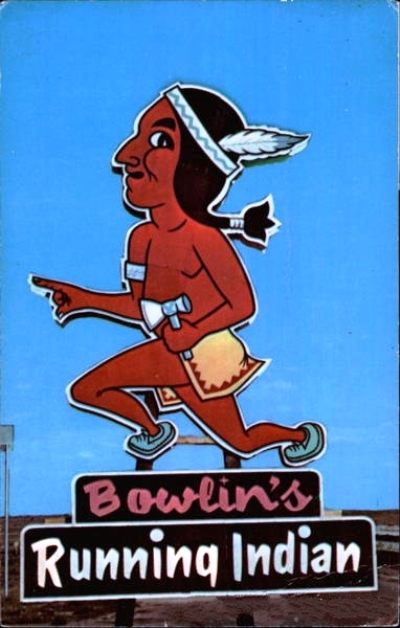
The Pink Pony Saloon and Dancehall was purchased by the Bowlin's family, who were famous for their trading post empire in New Mexico. The Pink Pony became the Running Indian, but may not have lasted long.
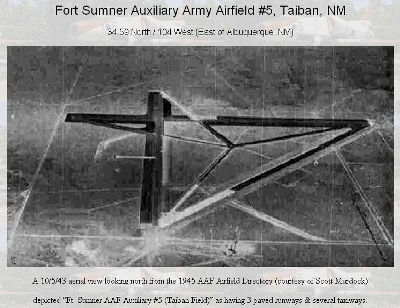
The airfield shown above is different than the one near the top of this update. It was probably located on the caprock just west of Highway 252, which leads north to HOUSE, NM, and used by the military as an emergency landing area back when the Fort Sumner Army Air Base was in operation. The M & M Cattle Company out of Amarillo, TX owned the land going back to the 1970's, but I've not heard who owns it now. It's said that for a long time you could see the outline of the runways, but nature finally reclaimed the place. The photo was taken on October 5, 1943, and comes from an interesting webpage called, Abandoned & Little Known Airfields: Eastern New Mexico.
I'm thrilled to add these rare photos to this archive of Taiban history. Again, many thanks to D. Burge and D. Schuyler for their generous contributions. JM
JANUARY 2018 UPDATE: Another postcard featuring Taiban has been kindly submitted by Dave S., who says, "There’s not a ton of there there, granted, but it does purport to show the actual site of the spring." Also of note is that this is the third postcard Dave has obtained bearing the inscription, "Pub. for J. R. Dumas, Taiban, N.M." One can't help but wonder how many images of Taiban were put on postcards for this Dumas person.
Thanks again, Dave S.! JM
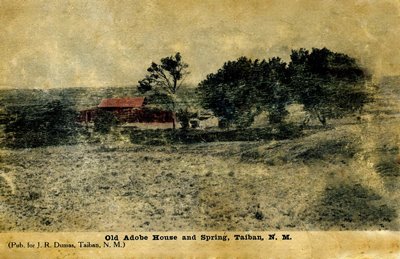
APRIL 2025 UPDATE: I recently received an email passing along some family history from Taiban and thought I'd include it here as it adds to the picture of the area 100+ years ago, It's got some intrigue, and if the folks involved sound familiar, please get in touch! Thanks very much to Susanna N. for sharing this!
"My mother was born in Taiban in 1923. I have been writing a bit of an history about our family as there are a few surprising facts I have learned, and so your blog was really helpful for background, altho most of the posts are from later than my mother’s time…
"So, here is what I know so far…
"We think my grandparents homesteaded in a dugout, and its possible their first child, born in 1914, may have arrived in the dugout, she was born in De Kalb.…their next child was born in Lubbock in 1921, where my grandmother had family. She may have gone to Taiban because she began cooking for the road (or railroad) gangs at around the time my grandfather was arrested and sent to prison in Albuquerque. He was found guilty of transporting a minor female across a state line, (charged using) the Mann Act of 1910. With two children, and no income, my grandmother had to find some kind of work. Interestingly, my mother was conceived and born after my grandfather got out of prison. I have no arrest or trial records so how this all came about, I cannot even speculate, but Grandma must have taken him back….!!!
"When my mother was about 5 years old, my grandfather disappeared out of their lives forever. Subsequently my investigations led me to the Univ of NM who were kindly able to locate the prison record for my grandfather, and the tidbit of information that he died in 1972! But no other information…
"I hope this finds you well, and that some if this information will contribute to your City of Dust archive. Obviously if there is any information you have that corroborates or enlarges any of this story…I would greatly appreciate hearing it!!"


 While loosely considered “Pueblo Deco,” Pop Shaffer’s vision is almost too singular and idiosyncratic to fit the term. While not exactly comforting, the hotel’s artwork, which includes painting, sculpture, and numerous things made out of rocks, all created by Pop himself, is pretty incredible. And, yes, it is jarring to see what appear to be swastikas scattered about. However, this is not the Nazi swastika, but a Navajo symbol, sometimes called "whirling logs," that represents healing and can face either left or right. Four large whirling logs that originally lined the top of the hotel have been covered over.
While loosely considered “Pueblo Deco,” Pop Shaffer’s vision is almost too singular and idiosyncratic to fit the term. While not exactly comforting, the hotel’s artwork, which includes painting, sculpture, and numerous things made out of rocks, all created by Pop himself, is pretty incredible. And, yes, it is jarring to see what appear to be swastikas scattered about. However, this is not the Nazi swastika, but a Navajo symbol, sometimes called "whirling logs," that represents healing and can face either left or right. Four large whirling logs that originally lined the top of the hotel have been covered over.




























